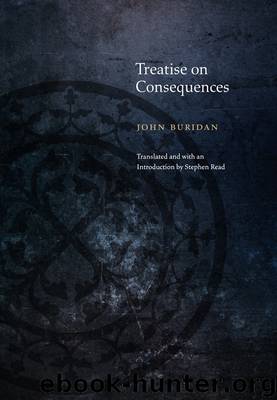Treatise on Consequences by John Buridan

Author:John Buridan
Language: eng
Format: epub
Publisher: Fordham University Press
Chapter 2: The Division of Modal Propositions into Composite and Divided
Now, in the second chapter, we must acknowledge that modal propositions of this sort are commonly of two types. For some are called “composite” and others “divided.” [p. 57]
They are called composite when a mode is the subject and a dictum is the predicate, or vice versa. I call the terms “possible,” “necessary,” “contingent” and the like “modes.” I call a “dictum” that whole occurring in the proposition in addition to the mode and copula and negations and signs or other determinations of the mode or the copula. For example, I call the following composite: “That a human runs is possible,” “It is necessary that a human is an animal.”1 The subject of the first of these is “that a human runs” and the predicate is “possible”; the subject of the second is “necessary,” and the predicate is “that a human is an animal.”
They are called “divided” when part of the dictum is the subject and the other part the predicate. The mode attaches to the copula as a determination of it. For example, “A human can run” or “A human is possibly running”; similarly, “A human is of necessity a runner” or “A human is necessarily running,” and the like. In these, the subject is “human” and the predicate is “runner.” The copula is the whole phrase “can be” or “is possibly” or “is of necessity” or “is necessarily.” For this proposition “A human is possibly running” should be analyzed into “A human is possibly a runner,” just as “A human is running” is [analyzed] into “A human is a runner.”
Download
This site does not store any files on its server. We only index and link to content provided by other sites. Please contact the content providers to delete copyright contents if any and email us, we'll remove relevant links or contents immediately.
The remains of the day by Kazuo Ishiguro(8814)
Tools of Titans by Timothy Ferriss(8211)
Giovanni's Room by James Baldwin(7187)
The Black Swan by Nassim Nicholas Taleb(7009)
Inner Engineering: A Yogi's Guide to Joy by Sadhguru(6722)
The Way of Zen by Alan W. Watts(6501)
Asking the Right Questions: A Guide to Critical Thinking by M. Neil Browne & Stuart M. Keeley(5627)
The Power of Now: A Guide to Spiritual Enlightenment by Eckhart Tolle(5602)
The Six Wives Of Henry VIII (WOMEN IN HISTORY) by Fraser Antonia(5394)
Astrophysics for People in a Hurry by Neil DeGrasse Tyson(5130)
Housekeeping by Marilynne Robinson(4328)
12 Rules for Life by Jordan B. Peterson(4249)
Double Down (Diary of a Wimpy Kid Book 11) by Jeff Kinney(4203)
The Ethical Slut by Janet W. Hardy(4172)
Skin in the Game by Nassim Nicholas Taleb(4160)
Ikigai by Héctor García & Francesc Miralles(4123)
The Art of Happiness by The Dalai Lama(4063)
Skin in the Game: Hidden Asymmetries in Daily Life by Nassim Nicholas Taleb(3929)
Walking by Henry David Thoreau(3892)
